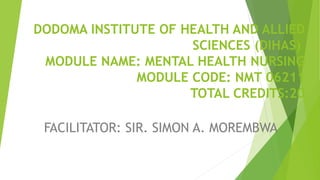
PRESENTATION 8_081830.pptx
- 1. DODOMA INSTITUTE OF HEALTH AND ALLIED SCIENCES (DIHAS) MODULE NAME: MENTAL HEALTH NURSING MODULE CODE: NMT 06211 TOTAL CREDITS:20 FACILITATOR: SIR. SIMON A. MOREMBWA
- 2. SESSION 08: MANAGEMENT OF PATIENT USING ELECTROCONVULSIVE THERAPY
- 3. Learning Tasks At the end of this session a learner is expected to be able: Define electroconvulsive therapy Explain the mode of action of Electroconvulsive Therapy (ECT) Identify the indication and contraindications of ECT Prepare patient for Electroconvulsive Therapy (ECT) Provide care to patient with mental disorders during ECT Provide care to patient with mental disorders after ECT Monitor complications of ECT
- 4. Definition of ECT ECT (Electroconvulsive Therapy) is a treatment that involves sending of briefly electrically stimulating current to the brain to trigger seizures in order to relieve the symptoms of some mental health problem. The treatment is given under a general anesthetic agents and using muscle relaxants, so that your muscles only twitch slightly, and your body does not convulse during the seizure
- 5. Mode of action of Electroconvulsive Therapy (ECT) It is a type of somatic treatment in which electric current is applied to the brain through electrodes placed on the templates. A grand mal (generalized) seizure produces the desired effect. It is given under a general anesthetic agents and using muscle relaxants, so that your muscles only twitch slightly, and your body does not convulse during the seizure Exact mechanism of action of ECT is still unknown though there are several theories which are trying
- 6. The most popular theories include Neurotransmitter theory suggests that ECT acts like tricyclic antidepressants by enhancing deficient neurotransmission in monoaminergic systems. Specifically it is through to improve dopaminergic, serotonergic, and adrenergic neurotransmission. ECT is effective for the following clients who are currently suicidal and in the treatment of severe depression, particularly in those clients who are also experiencing psychomotor retardation and neurovegetative changes such as disturbances in sleep, appetite and energy. The ECT is usually given twice per week and a course
- 7. NOTE:-ECT is often considered for treatment only after a trial of therapy with antidepressant medication has proved ineffective or when the patient is resistant to medication or when the patient is refractory to antidepressant medications
- 8. Indications and contraindications of Electroconvulsive Therapy (ECT) The indications for ECT are: Major Depressive disorder Suicidal thoughts or homicidal Puerperal depressive illness Mania Marked agitation, marked vegetative symptoms or Catatonic schizophrenia Schizoaffective disorder
- 9. The contraindications of ECT include; Raised intracranial pressure, High blood pressure, Any physical disorder- like cardiac and chest infections Epileptic patients
- 10. Preparation of Patient before Electroconvulsive Therapy (ECT) Preparation needed for a patient undergoing ECT include the following:- Educate regarding ECT, including the procedure and expected effects Teach family about the treatment Encourage expression of feelings by patient and family Obtain informed consent either from the patient or next of kin Help family members understand behavior related to amnesia and confusion Inform the patient not to eat anything from the midnight and
- 11. Give atropine and muscle relaxant to reduce secretions and movement of the patient during the therapy Check emergency equipment before procedure Check vital signs Remain available to offer support before and during treatment
- 12. Care of Patient with Mental Disorder during ECT The ECT is administered either by placing one electrode on each side of the skull (bilateral) or by placing both electrodes (Unilateral ) on the side of head containing non dominant hemisphere (the right side) Patient need to be supported firmly by about 4- 6 people during the procedure to avoid excessive jerking movements which may cause fractures. The nurse whom the patient feels at ease
- 13. The following are care of patient during ECT: Introduced all members of the treatment team and their specific roles in the ECT procedure to the patient Remove potentially harmful objects such as jewelry and dentures Place a bite in the patient’s mouth to prevent damage from biting during the convulsion Observe closely and record the effects of the ECT procedure and the patient’s reaction Monitor brain waves using electroencephalogram (EEG) Monitor cardiac responses using electrocardiogram (ECG) Monitor blood pressure throughout the treatment Maintain patent airways Offer analgesia or antiemetic as needed
- 14. Care of Patient with Mental Disorder After ECT Patients normally wake up about 15 minutes after ECT procedure. After awaking from ECT, the patient is often confused and disoriented for several hours Prepare equipment in the recovery area which must be adjacent to the treatment area. Equipment include oxygen, suction, pulse oximeter, vital sign monitoring, and emergency equipment. Observe the patient until awaking Monitor vital signs frequently until they return to normal Reorient the patient frequently
- 15. Provide close observation to prevent falls Assessment for gag reflex return, if present an analgesic may be administered, if headache is a recurrent problem a standing order for analgesic to be given as soon as possible after each treatment may be obtained. Change activity schedule and environment by providing a darkened room or quite area as possible Administer Cry therapy or a frozen gel band as an alternative approach due to its different mechanisms by which it relieves pain in patients with post –ECT headache
- 16. Monitoring of Complications of ECT The side effects of ECT Head ache, Temporary confusion, Loss of short-term memory, Fractures. The most common side effects of ECT are temporary memory loss and confusion
- 17. END THANKS FOR YOUR ATTENTION
- 18. Session Evaluation What are the indications for ECT? What are contraindications for ECT? What are the preparations needed for a patient undergoing ECT?